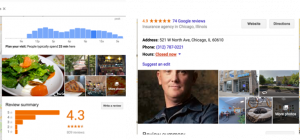Leverage These Local SEO Best Practices
Imagine that you’re an organization that relies heavily on maintaining a strong local presence. Insert your brand name restaurant chain, bank, or insurance agency here.
Over the last few months you’ve gone by the books and optimized your local pages for SEO (which we’ll call “Local SEO”). You’re starting to rank well, and your average rank is hovering between 8 and 20. Give yourself a pat on the back!
Wait, not so fast!
All of a sudden, your local pages hit a wall, and your rankings begin to tank. You’re no longer moving up, so you continue to test and optimize, meanwhile you wonder why you’re not able to outperform your competitors.
What’re they doing that I’m not? You ask yourself.
Well, you’re in good, if unfortunate, company.
Organizations of all sizes, shapes and business models commonly overlook very critical factors when optimizing for Local SEO. But don’t fear, we’re here to help you take advantage of them with these helpful tips…
Make full use of anchor text
Anchor text are the words or phrases that are visible as hyperlinks. This often forgotten about SEO item helps determine not only the topical relevance of your content, but also its the authority.
Having meaningful and relevant anchor text will drive you higher up in the ranks rather quickly. For anchor text to contribute positively to your SEO, it must be:
- Short and to the point
- Relevant to the page it’s linking out to
- Not packed with keywords (one or two is ok)
- Unique (for example, stay away from linking to text like “click here” or “buy now”)
Optimize your title, meta tags & page headers
In addition to anchor text, page titles and meta descriptions are either forgotten about or are optimized in total isolation. Headers, tragically, are almost universally ignored.
Make the most out of your pages by:
● Creating a holistic strategy for title, meta description and headers that takes into consideration the intent and audiences of different pages throughout your site; how can each page best fit into and support the larger puzzle?
- Well-structured meta tags will help people narrow their search down to your site, relevant titles will encourage then to choose your site, and headers will help them navigate to section of your site they are most interested in
- Your page title should give a clear indication of the solutions your offer as well as the location of your business; if you have multiple solutions or products, narrow down your list based on the TF-IDF for each of your products
- Use meta tags to provide additional details about the various solutions or products you offer, including any relevant discounts, awards, etc.
- Your page header should list details such as contact information, etc.
Finally, when you get around to testing these on-page elements, be sure to test them together. Group titles, metas and headers in groups against one another to see what’s performing best.
Don’t forget about your social profiles
As a rule of thumb, you should create separate Facebook, Twitter, Instagram, LinkedIn and other appropriate social accounts for each of your business locations.
Furthermore, you should be actively posting to each of these accounts on a regular basis (which, depending on the size of your business and the resources at hand, should be at least twice a week per account).
Add photos!
Photos have a tremendous effect on attracting and converting users. Think about it – when was the last time you visited a hotel, resort or restaurant without looking at their picture? Probably never, right?

The beauty of pictures is that it’s pretty much useful for any time of business you have. You can show off your business space, your food, your products, or just the friendly employees that make your business run!
Not only that, but photos provide authenticity to Google that business actually exists!




